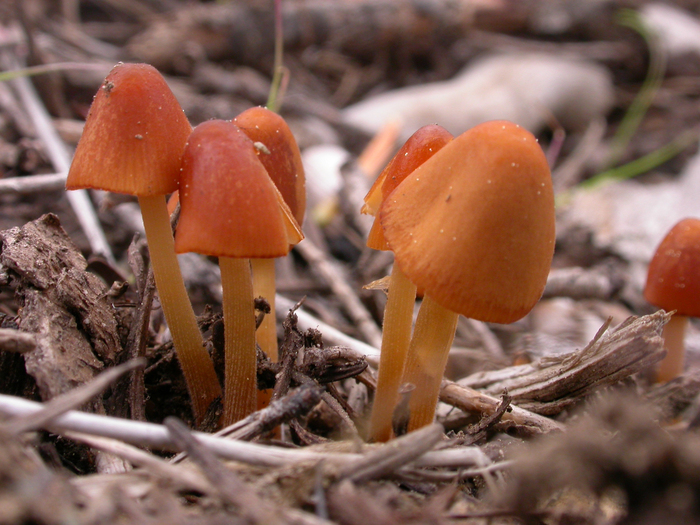
I don't know what these little orange guys are. They could be some kind of Mycena, or maybe a tiny Hygrocybe. They were growing in the clear cuts off of Woods & Steel road, south of Cle Elum, on 5-21-03.
The Cascade mountains force the moist ocean air up, and drain most of the moisture from the clouds down onto the Western slopes before the clouds pass over into Eastern Washington. This creates lots of microclimates within the Cascades, each with its own ecology. The Eastern slopes have different trees, different undergrowth, even a different smell... and, of course, different mushrooms. Notably, morels only grow on the Eastern slopes in Washington (except a few stray ones brought to the West side in wood chips, but those do not seem to get a permanent foothold).

I don't know what these little orange guys are. They could be some kind of Mycena, or maybe a tiny Hygrocybe. They were growing in the clear cuts off of Woods & Steel road, south of Cle Elum, on 5-21-03.
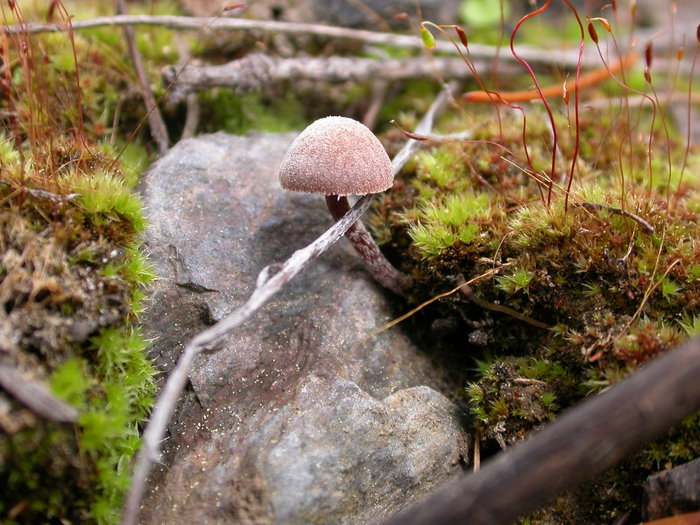
This pretty purple mushroom was growing in an area that had been slashed and burned off of Woods & Steel, on 5-21-03.
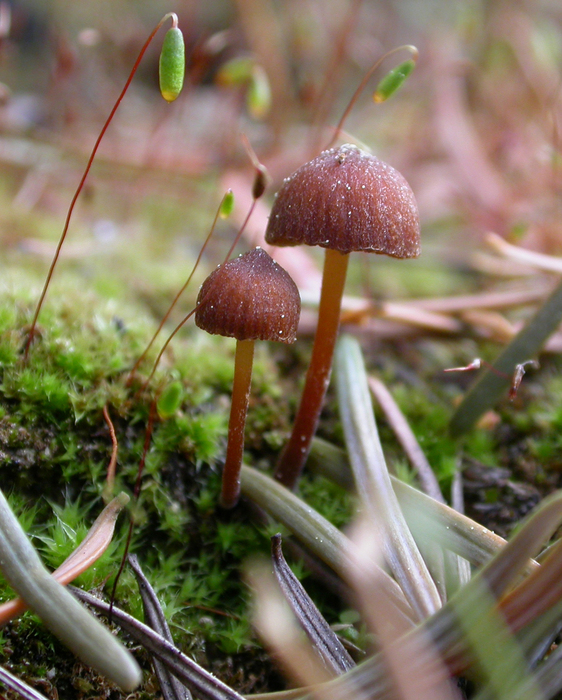
More small mushrooms with moss. These were photographed on 5-21-03, not far from the purple mushroom above.
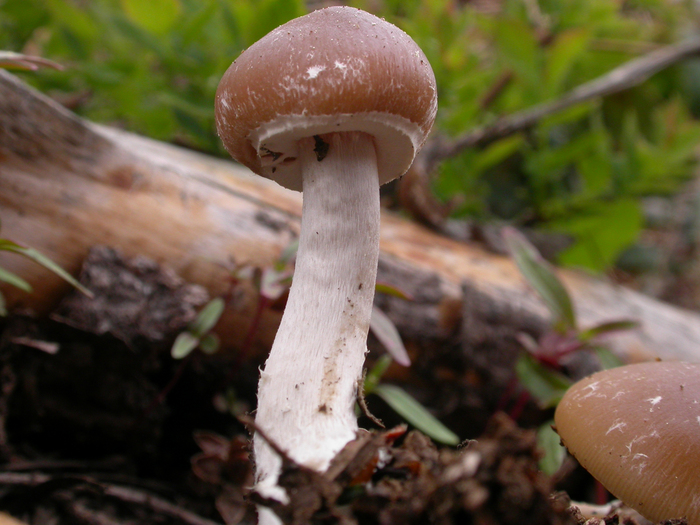
These mushrooms were very pretty in real life, but proved to be tricky to capture on film. The white fibrils on the cap are a little unusual, as is the thick, felty veil that is about to open on this one. The photo was taken in the clear cuts on 5-21-03.
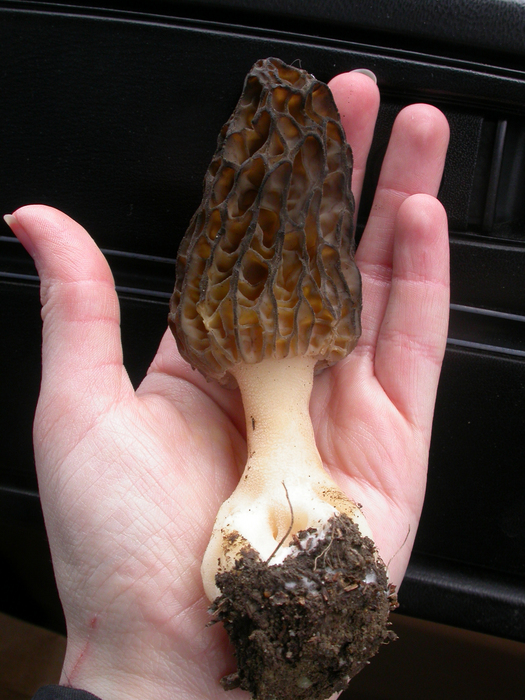
Clear cuts offer more than photos of unidentifiable mushrooms, though. Morels grow in clear cuts. This Morchella elata, or black morel, is quite large for its kind. Typical morels are about half this size. This photo was taken on 5-1-04.

Shortly after taking that photo, though, I found these guys. While on the old side, they were all still fine to eat, after washing the dirt off of them.

I have to admit, there is something inherently a little dirty
about morels... What can I say? I like them a lot.
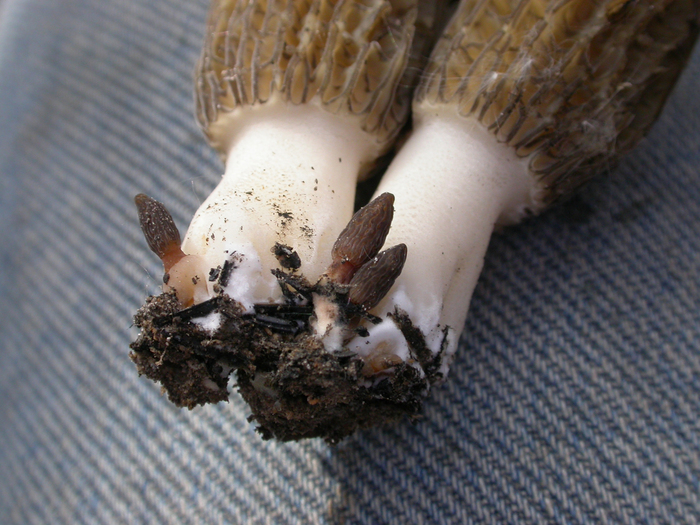
This neat photo of a pair of Siamese twin
morels shows morel pins
or babies growing up from the base. If I had known these guys were there, under the duff, I would have been more careful plucking the big ones. As it was, though, I took the opportunity for a photo. The background is the knee of my jeans, to give you a sense of scale. This photo is from Deer Point on 6-1-03.
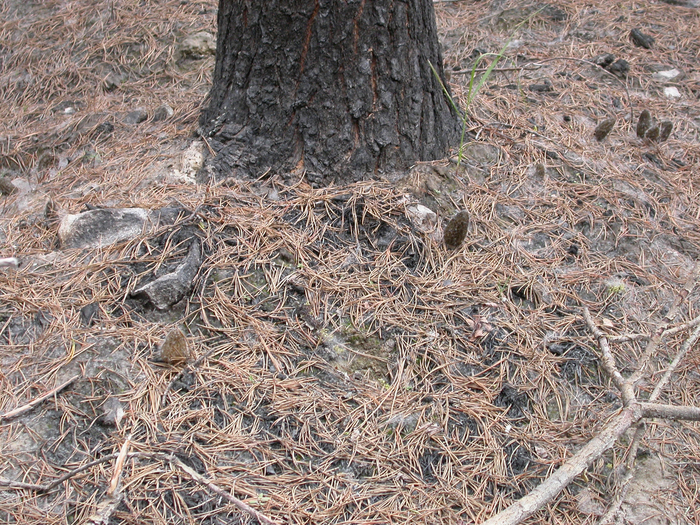
Forest fires are a major problem on the East side, where it is blazingly dry for months followed by electrical storms... and, of course, careless campers. Morels, though, seem to have an affection for growing in places of disaster – clear cuts and forest fires. Or, as Eric points out, We always go hunting in the ugliest parts of the forest.
There are two hypotheses of why morels my have such a predilection for ruin. One is that destruction of the plant life above drives the nutrients into the roots, where the morels can take advantage of them. Likewise, the ash changes the chemistry of the soil favorably for the morels. The hypothesis that I like better, though, notes that the morels are the fruiting bodies, the reproductive parts, of the Morchella fungus. When disaster strikes the fungus' environment, they produce fruting bodies (and therefore spores) like mad, in hopes to get their children
out of the ruined habitat and off to a better life. Given the tendency of humans to reproduce like bunnies in times of war, it doesn't seem like such an unlikely idea.
In any case, the practical repercussion is that morels grow in sometimes fabulous numbers in the spring following a summer or autumn forest fire.
See how many morels you can find in this picture, taken at Deer Point on 6-1-03. Some answers at the bottom of the page.
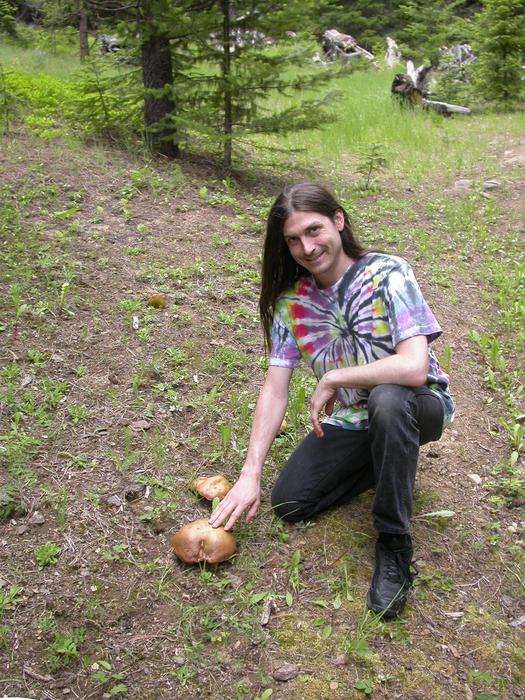
Boletes are mycorrhizal, meaning that they have a symbiotic relationship with a tree. This particular relationship must have been going somewhere!
Boletes will continue to come up in the same spot, year after year, and indeed there were a few (although not as many) back at the same spot the next spring. These photos are from 6-13-04... and no, we won't tell you where, other than to say it was off of Highway 97 between Cle Elum and Leavenworth.

Shortly after taking that photo, though, I found these guys. While on the old side, they were all still fine to eat, after washing the dirt off of them.

Boletes can grow to impressive sizes. This one was too old to eat, but its magnitude is illustrated by my shoe next to it. This photo was taken near Haney Meadows on 7-4-04.
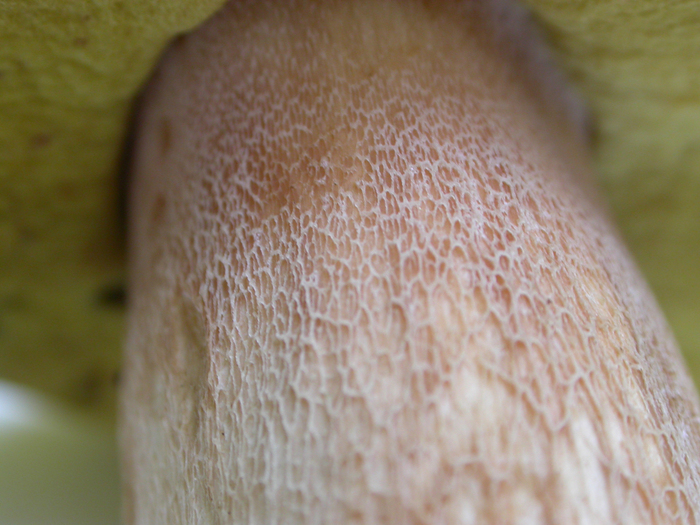
One way to differentiate King Boletes from all the other Boletus species is that they have fine netting or reticulations on the stalk, near the cap. Only a few other species have this characteristic, including, sadly, the bitter bolete.
This photo was taken off the shores of Lake Kachess on 6-19-03.

This pretty little mushrooms are examples of Calocybe onchina, or the plums and custard
mushroom. They are not edible, just pretty. This photo was taken at Mountainstar Resort (before they closed it to the public) on 5-11-03.
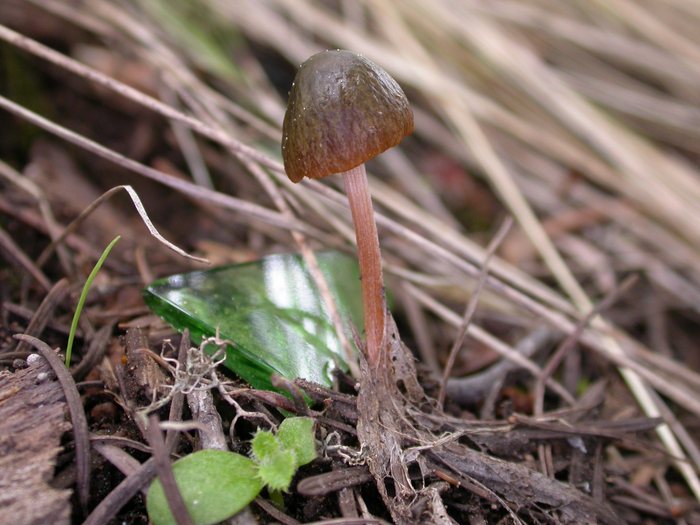
This little mushroom is a species of Conocybe, but I never managed to key it beyond that. Again, the colors are even better in real life – the top is a beautiful pine green, with the green following the ridges on the cap down into the margin, which is brick red. This photo was taken at Mountainstar on 5-11-03.
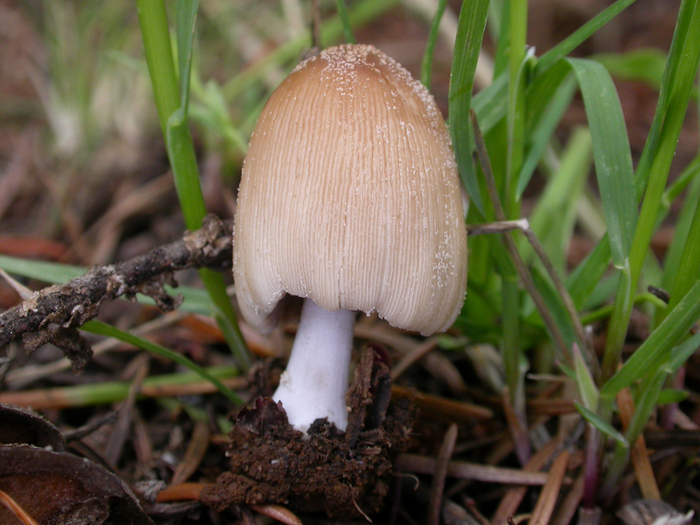
This is some species of inky cap, and might be Coprinus micaceus, but doesn't look quite like the pictures of that species that I have seen. As a Coprinus species, it is probably edible
provided that you don't drink alcohol within a few days of consuming it, which for me means it's not edible. There is a chemical in all Coprinus species, except Coprinus comatus, which reacts unpleasantly with alcohol – even if consumed a few days before or after eating the mushroom! This photo was taken on 5-11-03 at Mountainstar.
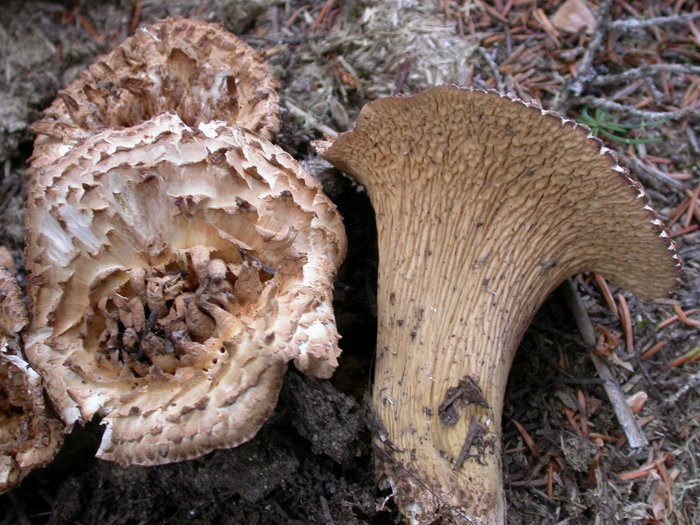
These are very typical examples of Gomphus floccosus, the scaly
or wooly
chanterelle. This is the only chanterelle
known to be toxic. Even so, it won't kill you, it'll just make you wish you were dead for a day or so, and some people seem immune to its ill effects and eat it with impunity. I have never found it worth the risk, though. Some people confuse these with the quite edible golden chanterelle, or the white chanterelle, which may seem absurd given these photos. However, the scaly does come in a much oranger hue, and sometimes the scales are not nearly as pronounced as they are in these very scaborous specimens. In fact, very young Gomphus look a lot like very young Cantharellus, although they are more square even at that stage, and usually lack the fine inrolled edge that baby Canthrellus usually have. The old rule if in doubt, throw it out
applies, I think... or, if dealing with Canthrellus pins, cover them gently with leaves (so other hunters won't find them first!) and come back next week to see what they've grown into.
This photo was taken on the Eastern side of Stevens Pass, near Rainy Creek, on 10-8-03.
Compare to Chanterelles from Icicle and Chanterelles from Western Washington, including an edible Gomphus species.
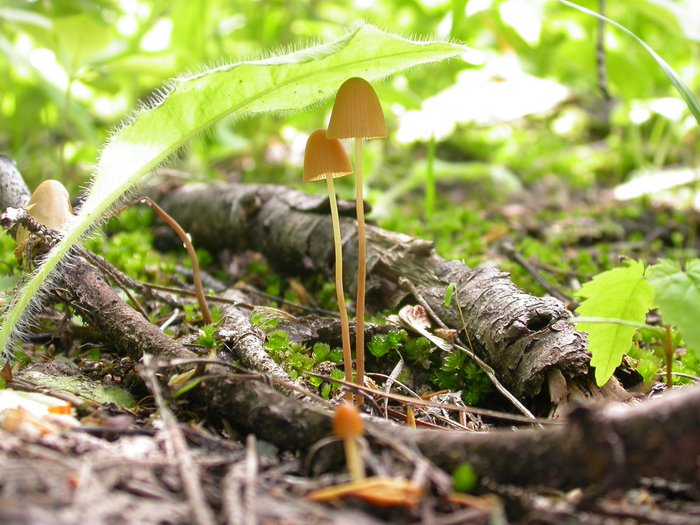
I really liked the set-up of these two little Mycenas sheltering under a fuzzy leaf, the light illuminating their gills from the back. This photo was taken on 5-31-04 in the Teanaway area, near Rosalyn.

Once you've been hunting mushrooms for a while, it starts to get easier to see them... even when they're not really there. This log is at a campground near Haney Meadows, and was photographed on 8-26-03.
In order to see the next set of photos, move the mouse so that the arrow on the screen moves into the blue field that says next page
. The arrow might change into a hand when you do this. Once it's inside the blue field, press the left button on the top of the mouse.
Back to Oregon
Back to location index